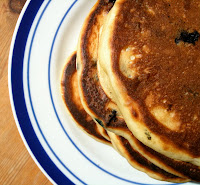
Ok, now that everybody has the basic homemade pizza recipe down pat, we can move on to more exciting variations. Like grilling (on the barbecue!), adding fresh herbs to the dough (rosemary!), turning the whole thing into a fancy tasty plate for a fresh salad (arugula!), and taking advantage of fresh seasonal produce (figs!). What's great about this is that it is fancy and tasty but still affordable and healthy. Oh, and my mom really really likes fig pizza.
I've been wanting to try grilling pizza for a while, and I'm glad I finally took the plunge. It's really not complicated once you figure it out. One of the really nice benefits of grilling pizza on the barbecue is that you can avoid the awful overheated kitchen (or whole house) that comes from cooking a pizza indoors. As my dad pointed out, mine was a very successful "maiden voyage." As I suspected the whole process wasn't too difficult, and the combination of the rosemary in the pizza dough, and the sweetness of the figs with the tartness of the goat cheese all topped off with the peppery bite of the arugula was pretty perfect. Especially eaten in the backyard with a glass of wine on a warm evening.
Whole Wheat Herbed Pizza Dough
Makes 2 pizzas (enough for 4 people)
3/4 cups warm water
1/4 cup white wine
1 1/2 tsp active dry yeast (or 1 tsp instant yeast)
1 tsp honey
2 tsp salt
2 Tbsp olive oil
2 cups all purpose white flour
1 cup whole wheat flour
1-2 tsp finely chopped fresh rosemary
In a large bowl, dissolve the yeast in the warm water and wine, then stir in the honey, salt and olive oil. Add the flour and rosemary, stirring until it comes together. Sprinkle your workspace with flour (I prefer using whole wheat), dump the dough out onto the flour, and knead it for a couple of minutes, until the texture is smooth and uniform. Form it into a nice, neat ball.
Coat the inside of a large bowl with olive oil, and place your dough ball in it, coating the dough lightly with olive oil. Cover the bowl with plastic wrap and let the dough rise in a warm place for an hour or two until it has doubled in size.
Once the dough has doubled, place it back on the floured work surface and gently deflate it. Using a sharp knife, neatly slice the dough in half. Form each half into round balls, pinching the seams of the cut sides together. Wipe the excess oil out of the large bowl and turn it upside down over the dough and let it rise, covered, for 15-30 more minutes. After this step, you will stretch or roll the dough as thinly as possible, at which point you will be ready to grill them.
In order to grill the pizzas you will need to have your barbecue to be hot, and you will need to have your toppings prepared.

Toppings
Figs (I used 8 figs, sliced into rounds)
1/2 small Red onion (thinly sliced)
5 oz soft goat cheese
Arugula
Balsamic vinegar & olive oil
Put together all of your toppings so that you can spread them on your pizza quickly and easily while it is on the grill. Slice the figs into nice little circles (I recommend eating the little bottom pieces, just to remind yourself of how good they are). Break the cheese up into small chunks with your fingers. After thinly slicing the red onion, soak it in some hot water to help take the bite off since it won't be cooked very much (you can skip this step if you don't mind raw onions). Wash and dry the arugula and lightly dress it with a little bit of balsamic vinegar and olive oil.

By now you should have all of your toppings prepared, your pizza dough should be stretched to it's desired thinness & shape, and your grill should be hot. I recommend having an extra plate, a pair of tongs, a brush (for the oil), and a hot pad handy.
When you are ready to get started, spread a little bit of olive oil on one side of the pizza dough and flip the dough over, oil side down onto the grill surface. Close the lid and wait for a few minutes, until you can see some nice grill marks on the bottom. At this point you can either oil the top and flip the pizza over, or you can forget to flip it and just rotate it and top it (like I did, with much success). Spread half of the toppings evenly over each pizza, close the top and keep cooking it until the dough is cooked all of the way through, and the cheese is meltingly warm.
Slide the pizza onto a plate (or cutting board) and slice it up! Top it with a handful of the dressed arugula if you like.







































.jpg)
.jpg)






